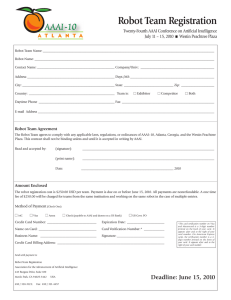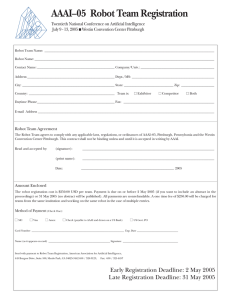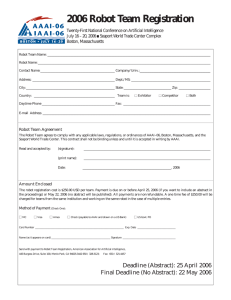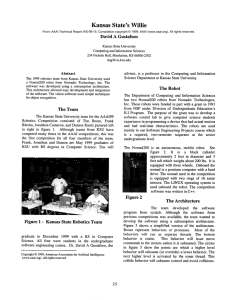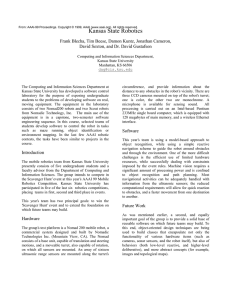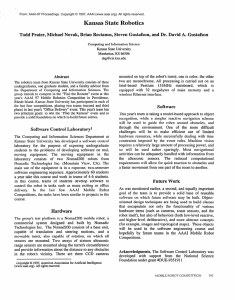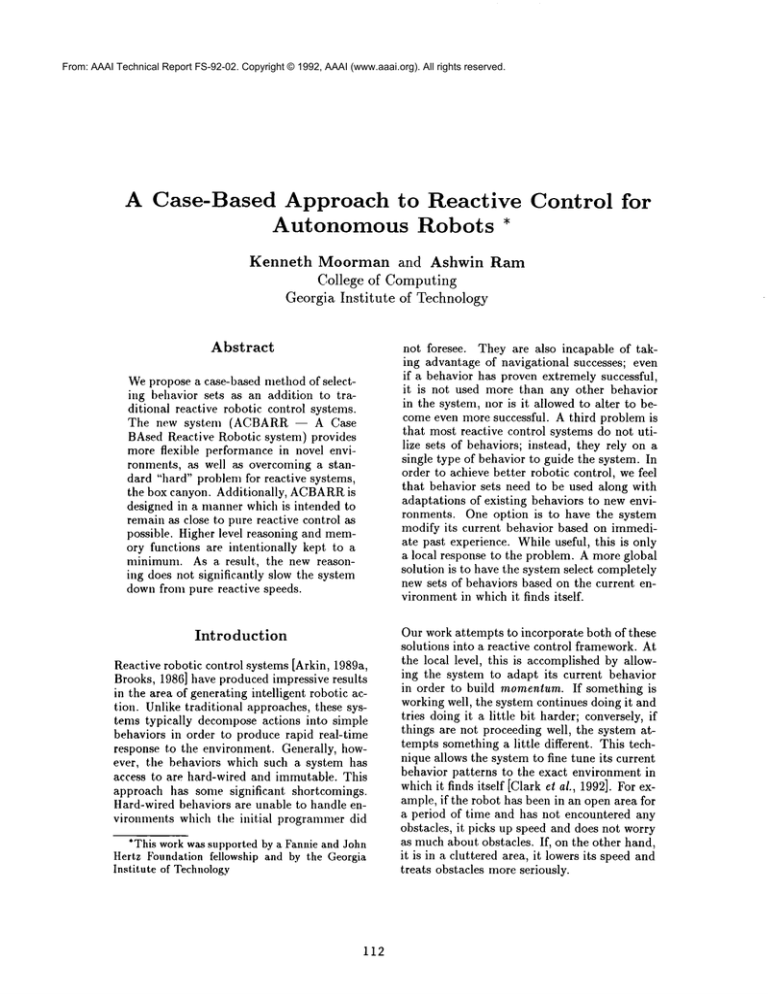
From: AAAI Technical Report FS-92-02. Copyright © 1992, AAAI (www.aaai.org). All rights reserved.
A Case-Based
Approach to Reactive
Control
Autonomous Robots *
Kenneth
Moorman
and Ashwin
College of Computing
Georgia Institute
of Technology
Abstract
for
Ram
not foresee. They are also incapable of taking advantage of navigational successes; even
if a behavior has proven extremely successful,
it is not used more than any other behavior
in the system, nor is it allowed to alter to become even more successful. A third problem is
that most reactive control systems do not utilize sets of behaviors; instead, they rely on a
single type of behavior to guide the system. In
order to achieve better robotic control, we feel
that behavior sets need to be used along with
adaptations of existing behaviors to new environments. One option is to have the system
modify its current behavior based on immediate past experience. While useful, this is only
a local response to the problem. A more global
solution is to have the system select completely
new sets of behaviors based on the current environmentin which it finds itself.
Wepropose a cause-based methodof selecting behavior sets as an addition to traditional reactive robotic control systems.
The new system (ACBARR -- A Case
BAsed Reactive Robotic system) provides
more flexible performance in novel environments, as well as overcoming a standard "hard" problem for reactive systems,
the box canyon. Additionally, ACBARR
is
designed in a manner which is intended to
remain as close to pure reactive control as
possible. Higher level reasoning and memory functions are intentionally kept to a
minimum. As a result, the new reasoning does not significantly slow the system
downfrom pure reactive speeds.
Introduction
Reactive robotic control systems [Arkin, 1989a,
Brooks, 1986] have produced impressive results
in the area of generating intelligent robotic action. Unlike traditional approaches, these systems typically decompose actions into simple
behaviors in order to produce rapid real-time
response to the environment. Generally, however, tile behaviors which such a system has
access to are hard-wired and immutable. This
approach has some significant shortcomings.
Hard-wired behaviors are unable to handle enviromnents which the initial programmer did
*This work was supported by a Fannie and John
Hertz Foundation fellowship and by the Georgia
Institute of Technology
112
Our work attempts to incorporate both of these
solutions into a reactive control framework. At
the local level, this is accomplished by allowing the system to adapt its current behavior
in order to build momentum. If something is
working well, the system continues doing it and
tries doing it a little bit harder; conversely, if
things are not proceeding well, the system attempts something a little different. This technique allows the system to fine tune its current
behavior patterns to the exact environment in
whichit finds itself [Clark et al., 1992]. For example, if the robot has been in an open area for
a period of time and has not encountered any
obstacles, it picks up speed and does not worry
as muchabout obstacles. If, on the other hand,
it is in a cluttered area, it lowers its speed and
treats obstacles more seriously.
From: AAAI Technical Report FS-92-02. Copyright © 1992, AAAI (www.aaai.org). All rights reserved.
The other methodused in our system is a global
level one. If the system is currently acting under the control of a set of behaviors which are
no longer suited to the current environment,
it should select a new set based on what the
enviromnent is now like. Applying this to the
above example, assume that the robot is in a
very cluttered environment and is employing
a conservative set. of motor behaviors. It then
"breaks out" of the obstacles and enters a large
open field (analogous to moving from a forested
area into a meadow).If only local changes were
allowed, the robot would eventually adjust to
the new environment. However, by allowing a
global change to take place, the system needs
only to realize that it is in a radically new environment and to select a new set of motor behaviors, one better suited to the new surroundings.
This paper describes
our work on ACBARR
(A Case-BAsed Reactive Robotic system),
system which performs both types of behavior modifications described above. The work
is a continuation of a line of research involving reactive systems in general [Arkin, 1989a,
Clark el al., 1992]. In addition, the system uses
case-based reasoning [Kolodner, 1990] to implement the global level of modifications. The system presented is extremely robust, doing well in
novel environments. Additionally, it is able to
navigate through several "hard" environments,
such as box canyons, in which traditional reactive systems would perform significantly worse.
As a result., the system is a step closer to the
lofty goal of having a truly autonomousrobot-one which can act and react in novel situations
without the need for human aid.
Overview of Reactive Control
using Schemas
Schema-based control is a type of reactive
robotic control system currently being used in
the Autonomous Robot Architecture
(AURA)
that is implemented on the Georgia Institute
of Technology autonomous robot, GEORGE
[Arkin, 1990]. Under this system, each basic type of motor behavior is represented by
a schema. By selecting the proper schema or
combination of schemas to employ the robot
is able to react to its environment. Various
113
schemas have been proposed; the ones used in
this research are the following:
¯ Avoid-Obstacle:
Repel from object with
variable gain and sphere of influence. Used
for collision avoidance.
Omagnitude : 0 for d > S
S-d
s_R*G
for
R<d<S
oo for d<_R
where:
S = Adjustable sphere of influence
(radial extent of force from
the center of the obstacle)
R = Radius of obstacle
G = Adjustable gain
d = Distance of robot to center
of obstacle
Odirection
= Along a line from robot
to center of obstacle
moving away from obstacle
¯ Move-to-Goal: Attract to goal with variable gain. Set high when heading for a particular goal.
V,,~a,~it~de = Adjustable gain value
Vdirection = Direction towards perceived
goal
¯ Noise: Random wander with variable gain
and persistence.
Used to overcome local
maxima,minima, cycles, and for exploration.
Nmagnitude---- Adjustable gain value
Nair~¢tion = Randomdirection that
persists for Npe,’~istencesteps
(Nre~,i~t~,~¢eis adjustable)
Move-to-Goal creates an attraction
between
the robot and the desired goal location,
hvoid-0bstacle creates a repulsive force between the robot and an obstacle, and Noise
provides for randomfluctuations on the robot’s
movement. The Noise schema is particularly
important for escaping from equilibrium points
in the force field. If caught at such a point,
the random nature of the noise should free the
robot. The vectors from the active sources are
added, forming a resultant movementvector for
the robot to use. For the purposes of this research, it is assumedthat there is only one goal
and multiple obstacles.
From: AAAI Technical Report FS-92-02. Copyright © 1992, AAAI (www.aaai.org). All rights reserved.
Ill order for tile system to make use of these
schemas, there are various gains associated
with each. These gain values determine the
impact level that a particular schema has on
the overall system behavior. A high goal gain
will cause the Move-to-Goal schema to have a
more pronounced effect on the system movement. In addition to the three gain values,
there are two other numerical values associated
with these schemas. Noise has a persistence as
well as a gain; since noise is a randomeffect,
the amount of time which a given bit of noise
affects the system is variable. Finally, the concept of sensible distance limits the area which
the robot is able to receive the effects froxn the
various obstacles around it.
what worked in the past on a certain problem
will more than likely work on a new problem
which is similar to the previous one. The quality of the solution which a CBRprogram will
generate is dependent on the following factors:
¯ the actual experiences (cases) which the system has had
¯ the ability to recognize that a new situation
is like a previous one (retrieval)
¯ adaptation of an old case to a new situation
¯ the ability to evaluate these retrieval and
adaptation processes and to repair any deficiencies which are identified
One of the key issues in case-bases reasoning
is that of retrieval. This process depends, in
part, on howwell the system’s cases are stored
in memory. Ideally, similar things should be
grouped together. However, the selection of
the proper set of features to index the cases
in memoryis a difficult problem and an ongoing research issue. This indexing problem has
been approached in a variety of ways (see, for
example, [Kolodner, 1992]), but none are totally effective. Each indexing methodis chosen
to be efficient for a given problemor situation.
If one has the proper set of gain values, optimal behavior can be achieved for the system in
question for a given environment and task. The
process of selecting the proper set of values, unfortunately, is not a simple one. The traditional
methodhas been to select a set of starting values for the gains. Then, the system is run on
a task in a particular environment. The actual
performance is then compared with the desired
performance and the set of gain values is adjusted accordingly. Whenno further increase
in performance can be achieved between two
successive runs, the training is declared complete.
Reactive control forms the base level of robotic
control within our system. Additionally, the
system permits the adaptation of values in order for a behavior set to becomebetter suited
for a given environment[Clark et al., 1992]. In
this way, the local adjustment technique discussed earlier is implemented within ACBARR.
There is still the question of howto implement
the more global behavior changes. To do this,
case-based reasoning is used to select sets of
behaviors appropriate for the current environment as perceived by the system.
Overview of Case-Based
Reasoning
Case-based reasoning (CBR)is an artificial intelligence technique which relies on past experiences to guide the reasoning process [Kolodner,
1990]. The hope in CBRis that past experiences will be applicable to new situations--
114
There are other problems inherent to the casebased paradigm which must be handled for
ACBARR
to be effective.
There is the question of knowing when to switch cases. There
is also the problem of what to do if there are
no complete matches in the case library when
attempting to perform a retrieval, only partial
matches. In order for the global control to be
implemented, all of these problems with casebased reasoning must be handled in some way.
The ACBARR System
ACBARR
is a combination of a traditional
reactive control system with ideas from casebased reasoning research. Figure 1 illustrates
the system’s high-level architecture.
Data
about the world is gathered by the environmental monitor and combined with the robot’s
status, which involves how well the robot is
moving in relation to the world. The system
uses this environmental information for two
things. It adjusts the current gain values of
the active schema, and it monitors the feedback
From: AAAI Technical Report FS-92-02. Copyright © 1992, AAAI (www.aaai.org). All rights reserved.
Environmental
Information
One of the goals of reactive control is to produce "intelligent" behavior without resorting to
higher-level reasoning processes, such as completely mapping a new environment and then
planning a near-perfect path through the obstacles. There are two problems with this high
level of reasoning. First, it involves a large
amount of overhead in the system, both in
terms of processing resources and time. This
means that the robot cannot immediately function in a new environment; it must first map
and analyze the world around it. Second, if the
environment is dynamic, the robot is faced with
a changing world. Reactive systems handle
both of these problems. Although case-based
reasoning requires some higher-level reasoning,
we did not want to have to add so much processing requirements that these benefits were
outweighed.
With this in mind, the following environmental
information is maintained about the world:
Figure 1: System architecture
for ACBARR
for a failure situation. If the failure identifier
determines that the current schema is failing,
then the case selector chooses a better behavior
schema from the case library.
A case within ACBARR’s
case library represents a set of behaviors which is well suited for
a particular environment. It contains both the
desired behavior and the environment in which
it should be applied, which acts as the index
for that case. The behavior information contains the new limits for each schemagain value
and how each is allowed to change while this
case is active. The environmental section represents the enviroument and movementstatus of
the robot under which to apply this set of gain
behaviors. The case selector has to determine
which index environment in the stored cases
best matches the current environment and then
switch to that case.
In order to understand the process more fully,
we now present the details of how each of the
components of the ACBARR
system operates.
115
¯ Clutter is a metric of how many obstacles
there are within the sensible distance of the
robot. To aid in case selection, the exact
number is converted into a class number representing a range of similar clutters. For example, for the purposes of selecting a strategy to use, seven obstacles and eight obstacles would be treated the same.
¯ Wander is a measure of how efficient the
robot’s current path is. This is determined
by examining the ratio of the robot’s current
path length over the actual distance between
the initial position and the goal.
¯ Maxxed is a binary value representing
whether the noise persistence has stayed at
its upper bound for a significant period of
time.
¯ Clear-to-goalis a binary value which, if true,
indicates that the robot is facing the goal and
there are no obstacles between it and the goal
along a straight line path.
¯ Senses-goal is a binary value which indicates
if the goal is within the robot’s sensible distance with nothing between the goal and the
robot.
¯ Goal-Nearbyis a binary value which indicates
if there the robot senses the goal but there
From: AAAI Technical Report FS-92-02. Copyright © 1992, AAAI (www.aaai.org). All rights reserved.
are obstacles between the two.
¯ No-Progress-With-Obstacles:
The robot
is moving but not toward the goal and there
are several obstacles within a sensible distance.
M > Tmovement
Hdist.... < Teroa,,,"
p
¯ Goal-Direction is a value, in radian angle
measure, which indicates which direction the
goal, relative to the current position and
heading of the robot.
Hgoal
Ocount ~_ Tobstacles
where:
Ocoun* = Average number of
sensible obstacles over
¯ Circles is a rough metric of how much the
robot, has recently traveled over the same
piece of ground, e.g. howmuchit is running
in circles.
Hsteps
Tobstacles ----
¯ Grannyis a binary variable which indicates if
the ultra-careful behavior should be selected.
Movement
Obstacle
count
threshold
¯ No-Progress-No-Obstacles:
The robot is
moving but not toward the goal and there
are no obstacles within a sensible distance.
M >_ Tmovement
p = nai.~ .... < Tprogress
information
Ueoa!
In addition to the information which ACBARR
maintains concerning its external environment,
it also needs information involving its internal
environment. This is knowledgeof how the current case behavior is performing, in terms of
the robot’s movementtowards the goal position. Ill particular, there are four situations to
which ACBARR
needs to pay attention:
¯ No-Movement: The robot’s average step
size has dropped below a certain threshold.
M <T,,,ove.~,~t
where:
M = Step size averaged over
Hsteps
Zrnovement
--
Movement
threshold
¯ Movement-Toward-Goal:
The robot’s
step size and rate of approach to the goal
are both above a threshold.
M> T,,~o~e,~,~t
p - Hd,,t .... > Yprogress
Ugoal
--
where:
Hdi.,t,.~_, = Distance travelled
over Hsteps
Hgo~t = Decrease in distance to
goal over Hsteps
Tp.ogr~... = Progress threshold
Ocount <: Tobstacle*
Short
term
memory
ACBARR
also employs a primitive short term
memory (STM) mechanism in order to recognize whether or not the robot is running in circles. The system is primitive as a matter of
choice. It was designed to keep the overhead of
ACBARR’s
additions to pure reactive control
as small as possible. There are not adequate
resources to maintain an in-depth model of a
dynamic environment while running in realtime. As a compromise, the STM system in
ACBARR
only keeps track of the robot’s travels within a small windowof the entire world.
The window is divided into quadrants through
which the robot travels. As long as the robot
remains within the window,its progress in each
quadrant is recorded. If ACBARR
determines
that the robot has been moving an excessive
amount within the window,it declares that the
robot is running in circles. If the robot moves
out of the window, then a new window is established and the old one is forgotten.
ACBARR case
description
An ACBARR
case entry consists of three sections. The first part represents bookkeepinginformation about the case. The second section
116
From: AAAI Technical Report FS-92-02. Copyright © 1992, AAAI (www.aaai.org). All rights reserved.
details howtile various gain values can change
and what their limits are. The remainder of
the case is a breakdownof the types of environments in which this case is applicable. This last
section is used when determining which case to
switch to.
A sample case is shown in Figure 2. Reading
tile data fromtile first table, we see that this is
case 1 which has a goodness rating of 90 percent. Additionally, we know that the average
step size was 0.5, there were no dynamic obstacles, and that the system was initially 37.56
units from the goal. Finally, the obstacle danger was 0.5 and the goal importance is 1.0.
These last two values are intended to allow the
system to navigate in environments where, for
example, some obstacles are more dangerous
than others and need to be treated in a special
Bookkeeping
Informa~
Parameter
case number
1
case goodness
0.9
average step size
0.5
dynamic obstacles
0
initial distance to goal 37.56
obstacle danger
0.5
goal importance
1.0
nlanner.
Tile second section of a case contains tile information describing the bounds on each gain
value in the system. Each value is associated
with two numeric ranges. The first describes
the limits for the changes which the system is
allowed to make on each value. In the sample
case, noise persistence has a limit on changes
of [-1.0 0.0]. The system is, therefore, allowed
to alter the noise persistence value by a number from -1.0 to 0.0. If a constant change is
desired, then the endpoints of the range simply
need to be equal. The rest of the data for each
value is the range which that value is allowed to
change. For noise persistence, this range is [1.0
5.0]. The system is allowed to change the value
of noise persistence by arcal number from -1.0
to 0.0, as long as the value remains between
1.0 and 5.0. These two ranges, then, represent
behavior which will successively decrease the
value until it reaches its lower bound; behavior such as this would be acceptable in an open
field.
Finally, the case contains information about
the types of environment that this behavior is
well suited for. This is a combination of the
environment knowledge along with the movement information. For the binary values, an
entry of-1 indicates that the system does not
care about this parameter. The sample case
is best suited for a non-cluttered environment.
The robot is making progress towards the goal
and is not wandering or running in circles. The
117
Gain Value Adjustments
Delta limits
Noise Persistence
[-1.0 0.0]
Noise Gain
[-0.05o.o]
Goal Gain
[o.o0.05]
Object Gain
[-0.01 -0.01]
Sensible Distance [-1.0 0.0]
Range
[1.o5.o]
[0.01 1.5]
[0.052.0]
[1.0 5.0]
[2.05.0]
ParameterEnvir°nmental
and Movem~
Clutter
0.0
Wander
0.0
Clear-to-goal flag
-1
Goal-nearby flag
-1
Circles
0
Granny
0
No-movement flag
-1
Movement-to-goal flag
1
No-progress-with-obstacles flag
-1
No-progress-with-no-obstacles flag
-1
Figure 2: Sample ACBARR
case
From: AAAI Technical Report FS-92-02. Copyright © 1992, AAAI (www.aaai.org). All rights reserved.
case doesn’t care if the goal is sensed or not,
nor does it care about the other three movement flags. If this case is selected, then the
modifications of gains which it describes will
take place.
Behaviors
stored
in the case
library
A reactive robotic simulatorI was first run several hundred times in order to gain insight into
the types of behavior different environments
would call for. This initial attempt to conceptualize the various schemas resulted in ten
strategies being identified:
1. Clear-Field: In an open environment, the
system should ignore the data about obstacles since there won’t be any, increase the
goal gain, and lower the noise gain and noise
persistence.
2. Ballooning: Whenthere are relatively few
obstacles,
the system attempts to swing
around them in a wide way (increase obstacle
gain).
7. Random: The system will raise the noise
gain and goal gain, leave the obstacle gain
at a mediumlevel, and wander for a period
of time.
8. Granny: After Hsteps, the system reconsiders the environment by actually attempting
to build a limited model of it. It concentrates on the location and sizes of the obstacles within sensible distance and attempts
to choose the direction which offers the best
success possibilities while deviating the least
from the goal direction.
9. Maxxed: If a value has remained at its maximumlevel for a period of time, the system
increases the maximumby some 6 value.
10. Repulsion: In certain situations, the system
considers moving away from the goal for a
period of time. This is accomplished by setting the goal gain to a negative amount.
Indexing
and case
selection
Since there is a limited number of cases in the
library, there is little need at this stage for a
sophisticated indexing scheme. As a result,
ACBARR
employs a flat memory model of the
case library [Kolodner, 1992]. Cases are located
by a sequential search of the memoryfor index matches. Although generally an inefficient
method, this suffices for the current system
without significant
slow-down. If ACBARR
was extended to include several dozen or possibly hundreds of cases, a better indexing scheme
would need to be implemented.
3. Squeezing: Whenthere are many obstacles,
the system attempts to find a path by squeezing between obstacles (lower obstacle gain,
increase the goal gain).
4. Hugging: When there are many obstacles
and the system is currently faced with an
obstacle directly in its path, it will attempt
to hug the side of the obstacle as it makesits
way around it.
There are no restrictions placed on the relationship between cases and known environments.
Multiple cases may be stored for the same environment, and a case may apply to multiple
environments. The system can handle both of
these scenarios with no problem.
5. Shooting: Regardless of the number and size
of the obstacles surrounding the robot, if it
see its goal and there are no obstacles in the
way, it will adopt the clear-field strategy and
go directly to it.
6. Wall-Crawling: If there is an obstacle the
system cannot seem to get around by hugging, it will check to see if it is actually in
front of a wall. If so, it determines which
way is the shorter side of it, and go for a
distance in that direction.
When to select a new case There are two
options available when using a case-based control system with regards to when a new case
should be selected. The first one is to have the
system look for a new case every H,t~p8 steps.
This ensures that the optimal behavior will always be in place. This is also a pessimistic
strategy. It assumes that every H~t~p, steps
the environment is going to be so changed that
a new case is needed, even if the current one has
1The simulator was written in standard C with
an X-Windows
interface. All test runs described
were performed on Sun SparcStation ls. For more
information concerningthe simulator, see [Clark et
al., 1992].
118
From: AAAI Technical Report FS-92-02. Copyright © 1992, AAAI (www.aaai.org). All rights reserved.
not failed. The second option is to select a new
case only if the current one is failing in some
way. This is the optimistic control strategy. It
assumes that a given case is "good enough" as
long as it does not actually fail. This is the
method currently used by ACBARR.It provides low system slowdown, while achieving respectable results.
environment; otherwise, why did it fail? On
the other hand, the matching criteria may not
be in error; this environment may be a fluke.
By selecting to choose the best case without
consideration of the current one, this problem
is minimized.
Empirical Testing
How to determine
failure
ACBARR
makes extensive use of its STMand enviroument knowledge to check for failing cases.
There are two criteria for failing. The first is
excessive wandering by tile robot. This is kept
track of by the wander entry in the environment data. If it rises above a given threshold,
failure is assumed. The second is tile condition
of running around in circles. This is kept track
of by the short-term me,nory which tracks tile
robot’s movementover a limited area of terrain. If the robot is not makingprogress out of
an area, then failure can be assumed.
How cases are matched Finally,
there is
the question of actually selecting the best case
from the case library. This is done in the
ACBARR
system through a goodness-of-match
metric. The matching algorithm attempts to
match the current environment to each known
case. If corresponding internal values in the
two cases are equal, then the goodness-ofmatch is incremented by 1. Near matches are
also handled. If, for example, the current environment is very cluttered and the case being considered is just moderately cluttered, the
goodness-of-match will have 0.5 added to it.
After all cases have been examined, the one
with the best match is chosen. Due to the numerical nature of the matching procedure, partial matches are taken care of as well as total
matches. If no total match is found which is
good, a partial match can be chosen.
Someadditional intelligence is also embedded
in the ACBARR
system. It has the option to
choose either the best case from the library or
to choose the best case without consideration
of the current case. Suppose the system is currently makinguse of case 1. At somepoint, the
system determines that a new case is needed
and selects the best one from the library, which
turns out to be case 1 again. Obviously, case 1
may not actually be the best case for the given
119
To test the program, sample runs were performed with ACBARR.Three predefined environments were used, as well as several random
ones. The predefined ones represented particularly difficult problems. These were a wall between the start position and the goal, a box
canyon, and a quasi-box canyon.
The ACBARR
system did not fail to find the
goal in any test run. Paths chosen in no clutter
to low cluttered environments were particularly
efficient.
ACBARR
was able to successfully
navigate the standard box canyon problem, the
quasi-box canyon problem (a box canyon with
an exit), and the wall environment (see Figure 5 through Figure 7) with no help from the
human operator.
As a test of the ACBARR
system, an ablation
study was performed on it [Cohen and Howe,
1988], in which the system was tested without
one or more of its componentsin order to evaluate their impact. Figure 3 shows the system’s
performance on the box canyon world with neither local adjustments nor global cases available to the system. As can be seen, the robot
achieves an equilibrium point and stays there.
Figure 4 shows the results of the system being
run on the same world, this time with adjustments permitted. The goal is reached, although
the path is wasteful. Finally, Figure 5 shows
the complete ACBARR
system’s performance.
With the benefits of both adjustments and case
knowledge, the system achieves its goal with a
fairly good path.
It was noticed in the empirical tests that the
system would generally use only a subset of
its stored possible strategies during test runs.
There were two reasons hypothesized for this
behavior. First, the system only alters a strategy if that strategy is failing in some way.
This means that the optimal strategy is not always in place. If the current strategy is "good
From: AAAI Technical Report FS-92-02. Copyright © 1992, AAAI (www.aaai.org). All rights reserved.
\
-\
Figure 3: Box canyon -- No cases,
znents allowed
no adjust-
Figure
Ho[tt-Pettittt[t
5: Box canyon --
Noite--~aZnGoe[-;l[n Db.t~t~t[n ~,[b[t-D~l~l~/
\\
Figure 4: Box canyon -- No case, but adjustments are permitted
Figure
120
ACBARR
\
\
6: Quasi-box
canyon --
ACBARR
From: AAAI Technical Report FS-92-02. Copyright © 1992, AAAI (www.aaai.org). All rights reserved.
looning and squeezing were relatively robust,
general-purpose strategies. As pointed out earlier, these did not turn out to be the most
used ones by the system. Luckily, there was
enough variety within the hand-created cases
to allow the system a relatively comprehensive
selection. Yet, the nagging question remains:
Is there a behavior even more robust and applicable than hugging (for instance) which
have overlooked? A second potential problem
is that a completely novel situation unseen by
the human teacher may not be handled in the
best way. If the system had the ability to learn
its owncases, this problem could be alleviated.
At the very least, the system needs to be able
to add new cases to an already existing library.
At the most, it would be desirable to produce
a system which could learn all of its cases from
scratch. Weare currently developing a system
which is capable of this automatic case learning.
\
\
\
Figure 7:
Wall environment
AC, BARR
problem --
enough," tile system will not bother to switch
to the optimal one. For example, if the system
initially chooses to make use of the clear-field
strategy, it will continue to do so until there is
a clear failure. This reason was shown to be
a correct explanation by altering ACBARR’s
control strategy so that new cases were selected
every H,t~p., steps. Upon doing this, more
movement strategies were utilized. The second reason for only a subset of strategies being
used was the robustness of several of the strategies involved. In particular, clear-field, hugging, and wall-crawling are especially robust.
These three alone can account for the majority
of behaviors noted in the system.
Future
work
An important issue at this point is where the
set of cases in the library comesfrom initially.
For now, these cases are coded by hand. This
is not the optimal solution for two reasons.
One, it allows humanbiases to enter the process. To illustrate this point, consider our own
experiences. At first, we believed that hal-
121
Another area of future work involves the actual implementation of the ACBARR
system
on a real robot. The work to date has been
restricted to the simulator. The transfer to
a physical robot should not be difficult, partially because AuRAis already implemented
on a physical system, GEORGE.Every effort
was made in the system so that it performed in
a way suitable for both a simulated world and
the real world.
Conclusion
Intuitively, combining case selection based on
environment with traditional reactive robotic
control systems should lead to better performance. The empirical data supports this claim
as well. By adding basic environmental data
to the system, we have increased the level of
its success. Wehave not sacrificed the inherent benefits of reactive control. Although the
ACBARR
system is not a pure reactive control
system as traditionally defined, it combines the
best features of that paradigm with the benefits of case-based reasoning. There is still the
chance that ACBARR
will fail in certain environments, although no such failures were identified in the extensive empirical testing. The
performance of the system is tightly coupled
with the adequacy of the cases in its library.
As pointed out, the cases currently in use have
From: AAAI Technical Report FS-92-02. Copyright © 1992, AAAI (www.aaai.org). All rights reserved.
proven to be extremely robust, making failure in new environments unlikely. This results
in ACBARR
being a highly efticient,
adaptive
control system.
References
[Arkin,1989a]RonaldC. Arkin.
Motor
schema-based
mobilerobotnavigation.
The
International Journal of Robotics Research,
8(4):92-112, August 1989.
[Arkin, 1989b] Ronald C. Arkin. Towards the
unification of navigational planning and reactive control. In the working note: AAAI
Fall Symposium on Robot Navigation, May
1989.
[Arkin, 1990] Ronald C. Arkin. Integrating behavioral, perceptual, and world knowledgein
reactive navigation. In Pattie Maes, editor,
Designing Autonomous Agents. The MIT
Press, Cambridge, Massachusetts, 1990.
[Brooks, 1986] Rodney Brooks. A robust layered control system for a mobile robot. IEEE
Journal of Robotics and Automation, RA2(1):14-23, August 1986.
[Clark et al., 1992] Russell J. Clark, Ronald C.
Arkin, and Ashwin Ram. Learning momentum: On-line performance enhancement for
reactive systems. Submitted to 1992 IEEE
International
Conference on Robotics and
Automation, Nice, France, May 1992.
[Cohen and Howe, 1988] Paul R. Cohen and
Adele E. Howe. How evaluation guides AI
research. AI Magazine, 9(4):35-43, Winter
1988.
[Kolodner, 1990] Janet L. Kolodner. An introduction to case-based reasoning. Technical
Report GIT-ICS-90/19, Georgia Institute of
Technology, 1990.
[Kolodner, 1992] Janet L. Kolodner. CaseBased Reasoning. Morgan Kaufmann Publishers, San Mateo, CA, 1992. In press.
122

